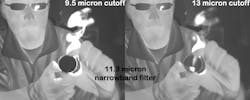Superlattice cameras add color to night-vision imaging
Evanston, IL--In addition to their recent development of a narrowband terahertz source, Manijeh Razeghi’s group at Northwestern University’s Center for Quantum Devices have built an infrared camera thatcan see more than one optical waveband or “color” in the dark. The semiconducting material used in the camera—a type-II superlattice—can be tuned to absorb a wide range of infrared wavelengths, and now, a number of distinct infrared bands at the same time.
The idea of capturing light simultaneously at different wavelengths is not new. Digital cameras in the visible spectrum are commonly equipped with detectors that sense red, green, and blue light to replicate a vast majority of colors perceived by the human eye. Multi-color detection in the infrared spectrum, however, offers unique functionalities beyond color representation. The resonant frequencies of compounds can often be found in this spectral range, which means that chemical spectroscopy can be relayed in images real-time.
"When coupled with image-processing algorithms performed on multiple wavebands, the amount of information rendered in a particular scene is tremendous," said Manijeh Razeghi, Walter P. Murphy Professor in Electrical Engineering and Computer Science at the McCormick School of Engineering and director of the Center for Quantum Devices.
Razeghi’s group engineered the detection energies on the cameras to be extremely narrow, close to one-tenth of an electron volt, in what is known as the long-wave infrared window. Creating the cameras was difficult, however, because the light-absorbing layers are prone to parasitic effects. Furthermore, the detectors were designed to be stacked one on top of another, which provided spatially coincident pixel registration but added significantly to the growth and fabrication challenges. Nevertheless, a dual-band long-wave infrared 320-by-256 sized type-II superlattice camera was demonstrated for the first time in the world, the results of which were published in the July 2011 issue of Optics Letters.
Even though such IR photon cameras based on mercury cadmium telluride (HgCdTe) were used in disaster relief in March 2011 when a catastrophic tsunami damaged Japans’ nuclear reactors, HgCdTe is an expensive technology in the long-wave infrared due to its poor spectral uniformity and therefore yield—areas in which type-II superlattices may prove more efficient.
SOURCE: Northwestern University; www.mccormick.northwestern.edu/news/articles/article_990.html
About the Author

Gail Overton
Senior Editor (2004-2020)
Gail has more than 30 years of engineering, marketing, product management, and editorial experience in the photonics and optical communications industry. Before joining the staff at Laser Focus World in 2004, she held many product management and product marketing roles in the fiber-optics industry, most notably at Hughes (El Segundo, CA), GTE Labs (Waltham, MA), Corning (Corning, NY), Photon Kinetics (Beaverton, OR), and Newport Corporation (Irvine, CA). During her marketing career, Gail published articles in WDM Solutions and Sensors magazine and traveled internationally to conduct product and sales training. Gail received her BS degree in physics, with an emphasis in optics, from San Diego State University in San Diego, CA in May 1986.
